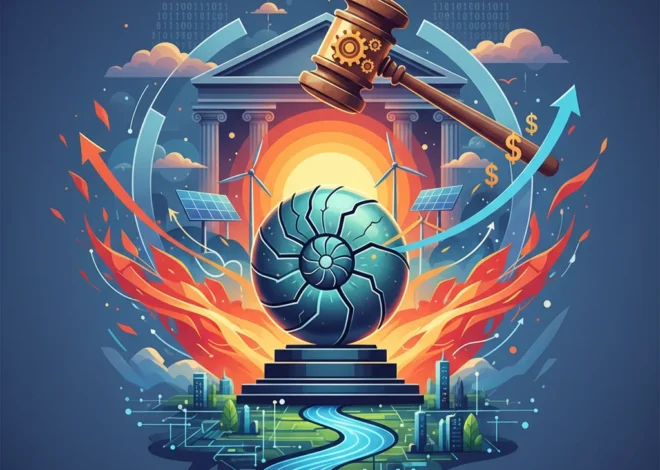
The Trillion-Dollar Legacy: How Climate Policy is Reshaping Finance and the Global Economy
The Unseen Ledger of Presidential Legacies
History judges leaders not just by the laws they pass or the speeches they deliver, but by the long-term economic trajectory they set for a nation. As Paul Bledsoe, a former member of the White House Climate Change Task Force, recently posited in a letter to the Financial Times, a president’s most destructive legacy might not be found in political scandals or partisan battles, but in a far more potent, yet often overlooked, area: climate policy. This isn’t merely an environmental issue; it is rapidly becoming the single most significant factor shaping the future of finance, investing, and the global economy.
For decades, the debate surrounding environmental regulation has been framed as a false choice between economic growth and ecological preservation. This outdated paradigm is collapsing under the weight of overwhelming evidence. Today, a failure to enact forward-thinking climate policy is a direct threat to economic stability and long-term prosperity. For investors, finance professionals, and business leaders, understanding this shift is no longer optional—it’s essential for survival and success in the 21st-century stock market and beyond.
Recalibrating Risk: The New Economics of Climate Change
The core of the issue lies in a fundamental concept in economics: externalities. For too long, the immense costs of pollution and climate change—from public health crises to infrastructure damage—were not priced into the market. They were “external,” borne by society at large rather than the polluters. That era is definitively over. The ledger is now being called due, with catastrophic weather events serving as the invoices.
In 2023 alone, the United States experienced a record-breaking 28 separate billion-dollar weather and climate disasters, with a total cost exceeding $92.9 billion, according to the National Oceanic and Atmospheric Administration (NOAA). These are not abstract figures; they represent shattered supply chains, crippled agricultural output, and skyrocketing insurance premiums. This is the new baseline of risk that modern banking and investment models must incorporate. A national policy that ignores or exacerbates these trends is, in effect, a policy of managed economic decline.
The financial world is waking up to this reality. Central banks, the traditional guardians of the economy, are now treating climate change as a primary threat to financial stability. They are developing sophisticated stress tests to determine how well financial institutions can withstand the shocks of both physical climate events and the economic transition to a low-carbon world. This represents a seismic shift in financial regulation and risk management.
Beyond the Dip: Why an XRP ETF Could Be the Next Big Catalyst in Digital Finance
The Specter of Stranded Assets in Modern Investing
Beyond the immediate physical risks, a more subtle but equally potent threat looms over the global financial system: stranded assets. This term refers to assets that suffer from premature write-downs or devaluations due to unforeseen changes, such as new regulations or shifts in market demand. In the context of climate, this primarily means the vast reserves of coal, oil, and gas that may become “unburnable” if the world adheres to its climate targets.
The potential value of these stranded assets is staggering. Some estimates place the figure in the trillions of dollars, representing a “carbon bubble” that could pop with devastating consequences for the stock market. Portfolios heavily weighted with fossil fuel companies, and the banks that finance them, are sitting on a ticking time bomb. A sudden, disorderly transition could trigger a financial crisis rivaling that of 2008. Proactive climate policy provides a predictable, orderly path to deflate this bubble, while inaction allows it to grow, increasing the systemic risk to the entire economy.
The Green Transition: The Greatest Economic Opportunity in a Century
While the risks of inaction are dire, the narrative is not solely one of doom and gloom. The flip side of this coin represents one of the most significant investment and economic growth opportunities since the industrial revolution. Decarbonizing the global economy requires a complete overhaul of our energy, transportation, and industrial systems—a monumental undertaking that will unlock trillions in new investment.
According to the International Energy Agency (IEA), annual clean energy investment worldwide has surged by 40% since 2020, reaching an estimated $1.7 trillion in 2023. For every dollar invested in fossil fuels, $1.7 now goes to clean energy. This is not driven by ideology, but by hard-nosed economics. The costs of solar, wind, and battery storage have plummeted, making them the cheapest sources of new energy generation in many parts of the world.
The following table illustrates the clear divergence in capital flows, highlighting where the future of the energy market is headed.
| Investment Area | Estimated Global Annual Investment (2023) | Key Growth Drivers |
|---|---|---|
| Clean Energy & Infrastructure | $1.7 Trillion | Falling technology costs, supportive policies, energy security concerns |
| Fossil Fuels (Oil, Gas, Coal) | $1.0 Trillion | Short-term energy demand, existing infrastructure |
Nations that create stable, long-term policies to attract this capital will become the economic powerhouses of the 21st century. They will dominate the manufacturing of wind turbines, solar panels, and electric vehicles; lead in green hydrogen and carbon capture technologies; and create millions of high-paying jobs. Conversely, countries that cling to the economic models of the past risk a severe competitive disadvantage, ceding leadership and prosperity to more forward-looking rivals.
Japan's Demographic Dilemma: Why More Stimulus Won't Fix a Shrinking Economy
Financial Technology: The Engine of the New Green Economy
This massive economic transformation is being accelerated and optimized by innovations in financial technology. Fintech is playing a crucial role in directing capital, managing risk, and creating transparency in the burgeoning green economy.
- ESG Investing Platforms: Fintech companies are democratizing sustainable investing, providing sophisticated tools that allow both retail and institutional investors to screen portfolios based on environmental, social, and governance (ESG) criteria. This puts market pressure on corporations to improve their climate performance.
- Blockchain and Carbon Trading: The integrity of carbon markets is paramount. Blockchain technology offers an immutable and transparent ledger for tracking and trading carbon credits, reducing fraud and ensuring that carbon offsets represent genuine emissions reductions. This enhances the efficiency of a key tool in the economics of decarbonization.
- AI-Powered Risk Modeling: Advanced financial technology is enabling banks and insurers to model complex climate risks with unprecedented accuracy. By analyzing vast datasets, AI can predict the financial impact of everything from sea-level rise on real estate portfolios to a carbon tax on industrial supply chains.
A Legacy Written in Red or Green Ink
Ultimately, the decision to embrace or reject a proactive climate agenda is an economic one with profound, long-lasting consequences. A legacy of denialism and policy reversal is a legacy of increased physical risk, a dangerously inflated carbon bubble, and a missed opportunity to lead in the industries of the future. It is a choice to write the nation’s economic future in red ink.
In contrast, a legacy of ambitious, consistent, and market-driven climate policy is one that mitigates systemic risk, unlocks trillions in private investment, and secures a nation’s economic competitiveness for generations to come. It is a choice to underwrite prosperity with the green ink of innovation and foresight. For anyone involved in finance, banking, or investing, the choice of which future to bet on has never been clearer.


